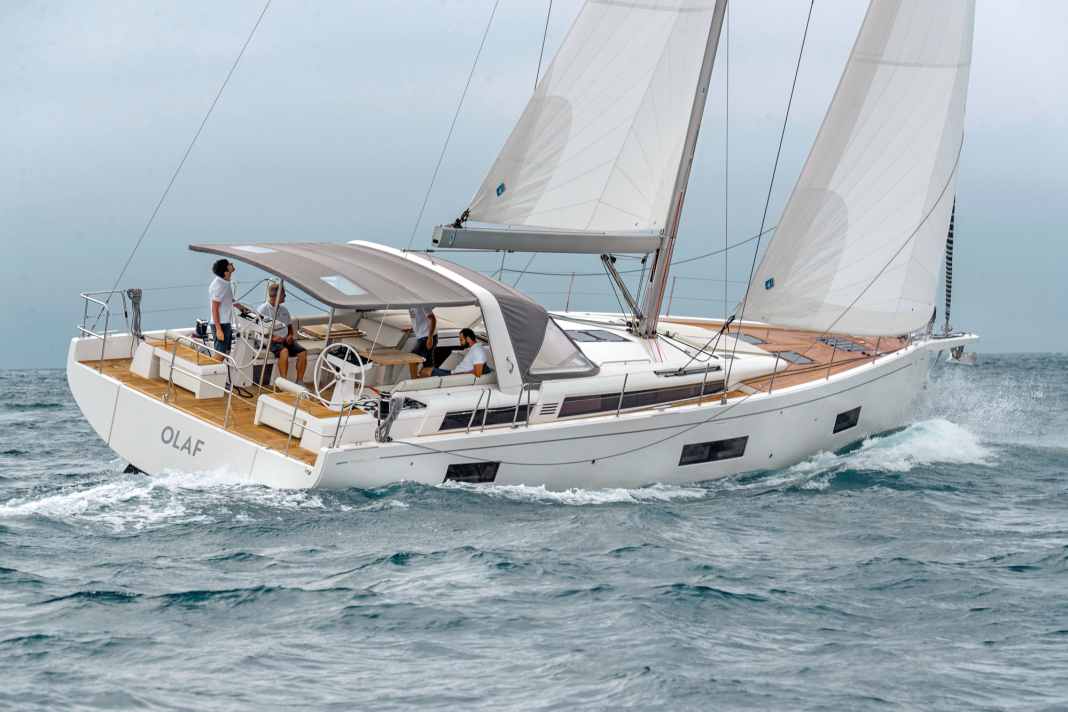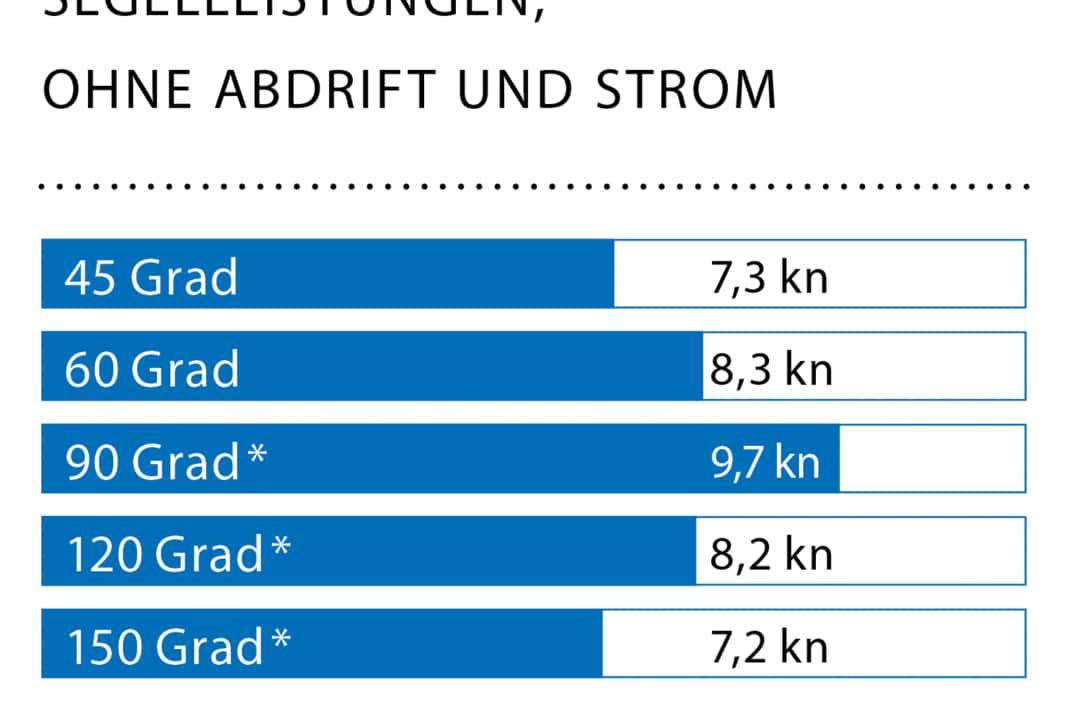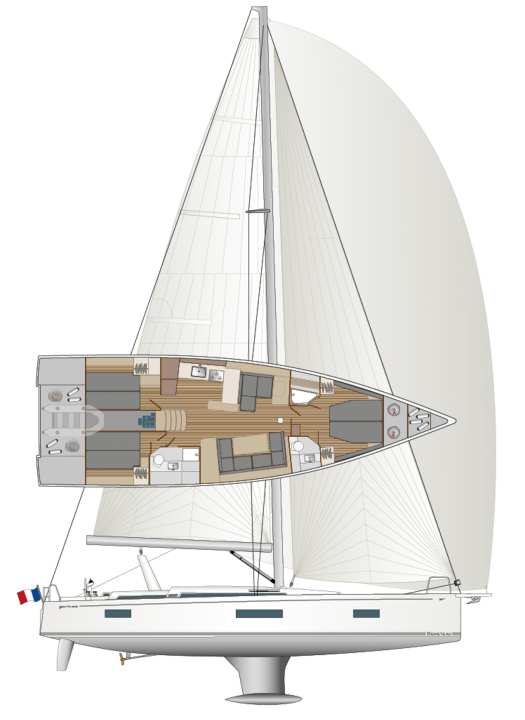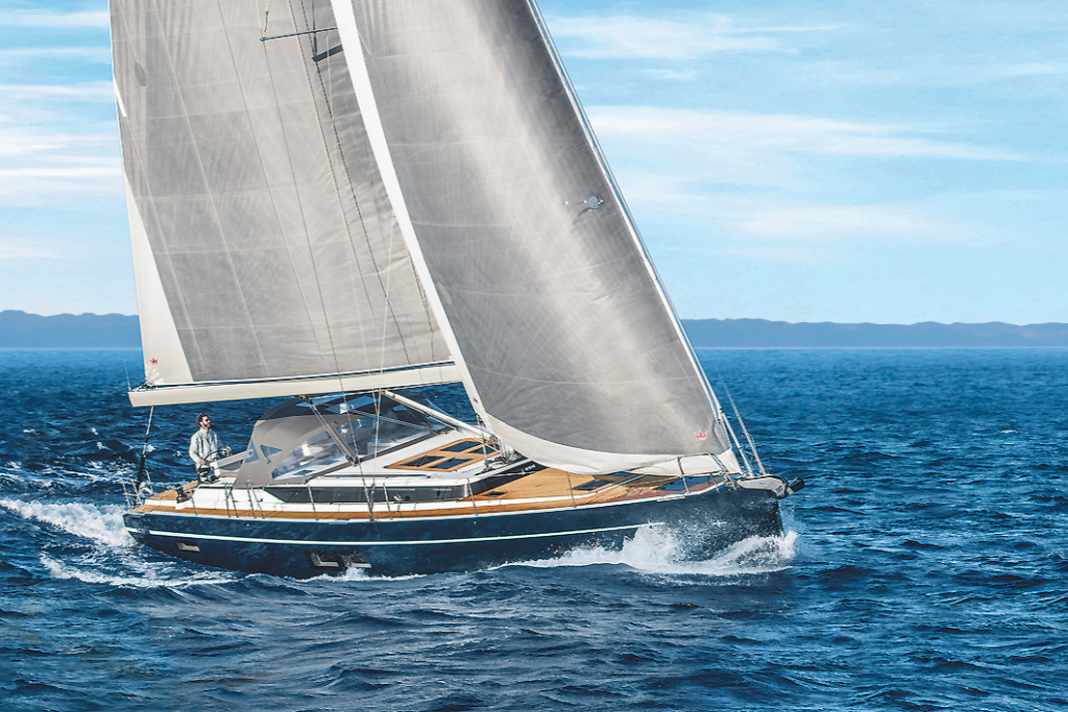





You might think that the developers at Beneteau have made it quite easy for themselves. They take the existing fast hull of the First 53, construct a new deck and a smaller rig on top of it, and make subtle changes to the interior design - and the metamorphosis from a powerful performance cruiser to the luxurious blue water vessel Oceanis Yacht 54 seems to be complete.
Really that simple? Probably not - quite the opposite. "It might have been less complicated and less costly to design a completely new boat from scratch," says Damien Jacob, Sailboat Product Manager at the industry leader. Rather, it is ultimately a rather bold and ambitious plan by the French to convert a dynamic and sporty fast cruiser into a comfortable cruising boat. "We have never done anything of this shape and size before, and the project is also a first for us," said the company at the 2020 launch.
With the First 53, market leader Beneteau intended to reactivate its sporty programme in the large format as well. The fast design comes from the office of Italian Roberto Biscontini, with the help of compatriot Lorenzo Argento, who is responsible for the lines and general styling.
An obviously fruitful co-operation: The First 53 impresses with its excellent and powerful sailing characteristics, but also with its exciting appearance. You can find everything about the boat in the YACHT test here.
With moderate lines
For the conversion to the blue water vessel Oceanis Yacht 54, the shipyard in France has given the boat a new deck with a slightly higher cabin superstructure and a redesigned cockpit layout. The keels in two variants are less deep, but still come in a T-shape. And the standard rig as a furling mast is also two metres shorter and carries less sail area. Damien Jacob calls the ship a kind of "slimmed-down version" compared to its counterpart from the First programme.
The Biscontini/Argento duo completely reworked their own plans for this. Unlike the other, comparatively rather radical-looking designs in Beneteau's cruising programme at the time, the hull of the Oceanis Yacht 54 has no chine edges. Instead, its appearance is characterised by strong, harmonious lines. This clearly sets the Italian design apart from many of its French counterparts in the industry. However, the powerful, wide stern with the round frame remains a defining feature, which makes double rudder blades essential.
Perfect sailing conditions during the test lead to decent performance data
The weather off Gruissan on the French Mediterranean coast was not exactly sparklingly beautiful for the test run with the new yacht, but the sailing conditions were perfect: constant 14 knots of wind with few gusts and gybes, plus a slight swell with a wave height of around 1.5 metres - it could hardly be better. The Oceanis Yacht 54 feels right at home. The test boat, equipped with a standard furling mast and an overlapping genoa instead of a self-tacking jib, works easily and relaxed against wind and waves under full sail. The French yacht reaches 7.3 knots at a tacking angle of 90 degrees.
These are decent performance figures for a designated touring boat weighing 16.6 tonnes and with no specific sporting ambitions. A rollable Code Zero is attached for the downwind section. This gives the Oceanis Yacht 54 a lively character. The log sometimes soars into double figures. Steering is a pleasure because the boat reacts immediately and lively and the helmsman can always steer according to pressure. The high-quality system from Jefa is set very directly, probably based on experience with the First 53, which has the same control system.
Practical walkaround concept
The halyards as well as all sheets and trim lines are deflected aft from the mast foot under the cabin superstructure and inside the cockpit coaming. They only come back on deck just before the steering area. Two large winches are available on both sides for this purpose, which can be easily operated by the helmsman.
As with the First 53, the running deck of the Oceanis Yacht 54 is stepped aft to the level of the cockpit floor. So if you want to go from the cockpit to the foredeck, you can walk seamlessly around the steering areas aft and reach your destination without any awkward climbing. In the aft part of the running deck, you move in a kind of channel between the retracted cockpit coaming and the high bulwark. This provides safety in wind and waves. What's more, the railing is positioned as a handrail at a favourable height of 90 centimetres above the running deck. The innovative layout also offers good working positions for handling lines and winches from outside the cockpit. Jeanneau has already successfully implemented this so-called walkaround concept in a similar form for its latest boats in the Sun Odyssey series.
Not pretty, but useful
As standard, the Oceanis Yacht 54 is equipped with a massive targa bow above the cockpit. The solid GRP bow banishes the mainsheet from the cockpit and also offers advantages when trimming the sails, as the boom can be pulled more towards the centre with less sheet pull. On the test boat, the targa bow also serves as a base for attaching the powerful sprayhood and a semi-rigid bimini, which covers the entire cockpit area for protection. However, the sun canopy also considerably restricts the view of the sails from the steering position - a compromise.
A dinghy garage is installed in the stern as a completely sealed GRP moulding. A small dinghy (up to 2.40 metres) can be stowed lengthways here without having to deflate. If you are travelling without a dinghy, you can also use the lazarette as storage space for larger items that do not necessarily have to stay dry. Although there are seals between the large bathing platform and the stern, waves can still push water in here from time to time.
The two forecastle boxes in the cockpit are rather small. For sails such as a gennaker or code zero, for additional upholstery or the fenders, a very spacious load is provided in the bow, which is even accessible. Optionally, as on the test boat, the forepeak can be converted into a cabin for the skipper with his own toilet and washing facilities. In this case, however, the storage space on deck would be rather tight.
Inside, the Oceanis Yacht 54 offers few alternatives
The layout concept of the Oceanis Yacht 54 raises questions. Like the First 53, the ship is only available with three double cabins without exception. Beneteau is thus exclusively targeting the market for private owners. This is all the more surprising given that comparable yachts of the same hull length are available with three, four, five or even six double cabins. Beneteau manager Damien Jacob explains that this project is not orientated towards the competition from the large construction series, but aims to present an independent, individual and also upmarket offer for owners. For enquiries from the charter market, Beneteau instead refers to its Oceanis touring series. The largest boat in the range, the 51.1 (test here ), remains one metre shorter than the Oceanis Yacht 54, but is available in extension versions with up to five cabins plus skipper's cabin and is therefore also very interesting for the charter industry.
The only alternative extension for the Oceanis Yacht 54 comes in the form of an additional, third toilet room aft. If you want this, you will have to accept compromises in terms of space in the otherwise very spacious aft cabin as well as restrictions in terms of work surfaces and storage space in the galley.
In the foredeck, the large island bed has a generous width of 1.60 metres at shoulder height. The owner's area there has two heads compartments. The spacious shower is separate from the toilet room, which includes a washbasin and toilet. In addition, there is no lack of storage space and ventilation options at the front. The aft cabins also offer a high standard of cosiness. The double beds are square over the entire length of more than two metres and are 1.40 metres wide throughout.
From sporty to luxurious: a miraculous change of direction
Beneteau has set up a dinette on the port side of the saloon on the near-swesterly First 53, where four to six people can dine comfortably. Meanwhile, the L-shaped sofa on the opposite side is reserved for relaxation with a small coffee table - an unusual but interesting layout. On the touring-orientated Oceanis Yacht 54, the layout remains more conventional, with a U-shaped seating area around a large dining table, which can be lowered for conversion into an additional double berth. Instead of the dinette, the new yacht has a fully-fledged navigation system with a functional layout at the front of the main bulkhead. The shipyard has combined this area with a kind of chaise longue. The comfortable chaise longue is suitable for reading or for a quick rest on long trips.
The silence in the living area is striking when sailing. The noise from the waves hitting the hull or from working on the sails during manoeuvres is barely perceptible. Beneteau builds the deck and hull as GRP sandwich constructions using a vacuum infusion process with a 25 millimetre thick core of balsa wood. This construction method ensures excellent insulation, both thermally and especially acoustically.
The boat is expensive in comparison - but there is a reason for that
With a base price of almost 690,000 euros, the Oceanis Yacht 54 is a good deal more expensive than the similarly sized yachts produced by the main competitors Bavaria, Dufour, Hanse or Jeanneau. The additional price can be justified by the good and extensive deck equipment, the elaborate construction and the high standard of equipment at an above-average level of quality. In addition, there are numerous gadgets that Beneteau already supplies as standard from the shipyard. For example, the innovative "Ship Control" system, which can be used to control and access all current boat data and large parts of the ship's technology, even via smartphone.
Converting a proven performance cruiser to meet the demands of cruising sailors is a bold and exciting endeavour in equal measure. It would probably be easier to go the other way round. With the Oceanis Yacht 54, a boat is now being launched on the market that trumps with its independent concept and clearly stands out from the mass market. A good plan well realised - all respect!
The measured values for the test of the Oceanis Yacht 54




The Oceanis Yacht 54 in detail

Technical data of the Oceanis Yacht 54
- Design engineer:Biscontini Y. D.
- CE design category: A
- Torso length:15,98 m
- Width:5,00 m
- Draught/alternative:2,50/1,95 m
- Weight:16,6 t
- Ballast/proportion:4,5 t/27 %
- Mainsail (furling mast):63,0 m²
- Self-tacking jib (furling mast):51,0 m²
- machine (Yanmar):58 kW/80 hp
Hull and deck construction
GRP sandwich construction with balsa wood core, built with vacuum infusion. Floor assembly glued to fuselage
Price and shipyard
- Base price ex shipyard:689,725 € gross, incl. VAT.
- Guarantee/against osmosis: 2/2 years
Shipyard
Beneteau, Saint-Gilles-Croix de-Vie (FRA); www.beneteau.com
Distribution
Dealer network
YACHT rating
Attractive cruising boat based on the First 53 fast cruiser, with a new cockpit layout and reduced sail plan. The concept is aimed at private owners and offers many options. Comparatively high price
Design and concept
- + Harmonic hull lines
- + Innovative cockpit layout
- - Few variants for the interior fittings
Sailing performance and trim
- + Very sensitive control
- + Good handling also for soloists
Living and finishing quality
- + Very spacious owner's cabin
- + Separate wet room at the front
- + High finishing quality
Equipment and technology
- + Solidly designed control unit
- + Enclosed garage for the dinghy
- - Only small cockpit lockers
This article first appeared in YACHT 23/2020 and has been updated for this online version.
The competition of the Oceanis Yacht 54





- Bavaria C57
- Dufour 530: Dufour shows greatness at boot Düsseldorf
- Hanse 548
- Jeanneau Yacht 54
More boats from the series:
- Beneteau Oceanis 30.1: Strong competitor in the entry-level class
- Oceanis 34.1 test: cruising yacht bestseller with many faces
- Beneteau Oceanis 37.1: Test of the new edition of the French bestseller
- Oceanis 40.1: cruising yacht with radical lines and plenty of volume
- Oceanis 361 as a used boat: Solid cruising yacht from the large series

